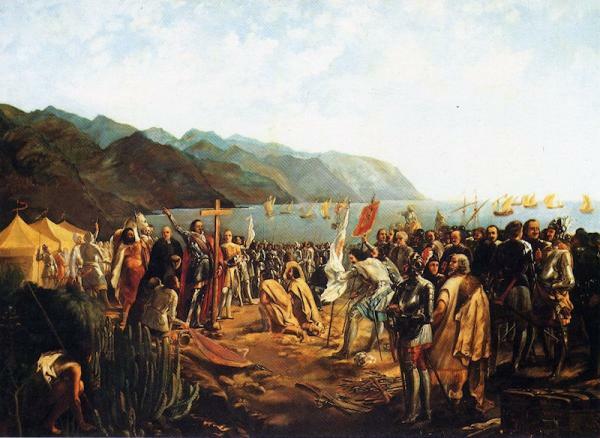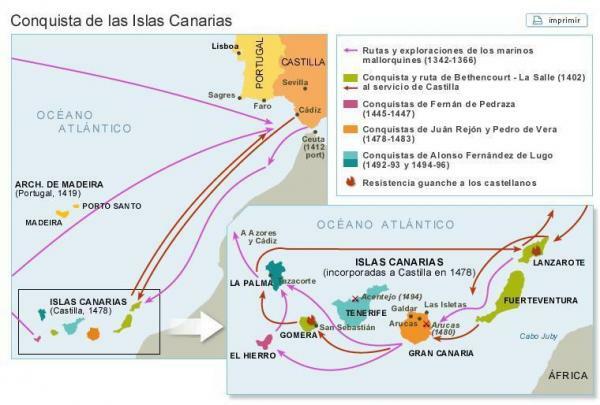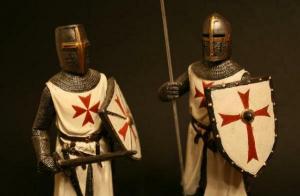Conquest of the Canary Islands by the Crown of Castile

Image: Canarias en red
Since the fall of the Roman Empire the archipelago of the Canary Islands was found practically isolated from the rest of Europe although some approaches of populations from Africa and some Christian kingdoms such as the Portuguese and the Aragonese are known. Being therefore from the Low Middle Ages when they began greater relations with the peoples that inhabited them. In this lesson from a TEACHER we bring you the conquest of the Canary Islands by the Crown of Castile dividing within this long stage two essential parts that marked the history of the islands.
Within our lesson on the conquest of the Canary Islands by the Crown of Castile, we must know that between the years 1402 and 1496 the annexation of the islands would take place. As we have mentioned previously, the resistance that the aborigines had to the conquest was exceptional, being these completely annihilated.
In the same way, during and after the conquest, we will find a series of political problems related to the nobility who had invested a lot in the campaign and it was obvious that they would seek benefits.
We can divide the conquest into two parts fundamental:
Stately conquest
It was paid for by the nobility since it looked for a great benefit in this campaign. They had to ask the Crown for permission but it would never participate in it, although the territories would swell it.
At first, we will find the conquest carried out by Jean de Bethencourt and Gadifer de la Salle, who between 1402-1405 would focus on the islands of Lanzarote, El Hierro and Fuerteventura. On the other hand, and within this, the Castilian manorial conquest is located, which the aforementioned islands were obtaining through purchases, in addition to joining La Gomera in the year 1450.
Conquest of the Crown
With the arrival of the Catholic kings, the power of the Castilian nobles was greatly diminishing. So they took control of the situation, in that way, they armed a professional army and began the conquest of Gran Canaria in the year 1478, Tenerife and La Palma, concluding the conquest in the year 1496.

Image: iris.cnice.mec.es
Continuing with our lesson on the conquest of the Canary Islands by the Crown of Castile, we stop at the private conquest which was made from a large part of the islands that make up the archipelago.
The first to leave in search of benefits was, without a doubt, Jean de Bethencourt who swore allegiance to the King of Castile in exchange for being able to leave for said lands. In this way, Castile obtained new territories while the noble obtained the rights to the lands.
At that time, therefore, the Siege of Lanzarote in 1402 where its inhabitants, the Mahos, must have surrendered to the European advance. After this they created a fort in the south of the island, called Rubricón, and in the same area a bishopric was established, whose name was San Marcial.
After this first period between 1402-1405, the conquest of Fuerteventura, well the Aboriginal resistance it was quite high. In addition, it would be joined by a problem of lack of food and men, which is why Jean de Bethencourt had to march to the Castilian Court to receive from the hands of Henry III everything necessary to complete the conquest of the Island.
While this was in the peninsula, a group of exalted rebelled against what was established by the lords, this being pacified in the year 1404. With the help of Castilla, Fuerteventura would fall in the year 1405, becoming the kings of this, vassals of the peninsular kingdom.
Finally, the Norman nobleman would make one last conquest over the Isla del Hierro, also in the year 1405In that place he would hardly find resistance from the small aboriginal group that inhabited it, who were taken prisoner and sold as slaves.
In the year 1412, Jean de Bethencourt, marched to Normandy, yielding his rights to a relative of his, Maciot.
Purchase of the islands
In a second moment we must stop at the purchase made by the Count of Niebla on the islands that had obtained by Maciot, in the year 1418, in this way the Castilian power became much more present in the archipelago.
From that moment until 1477, meet those islands under noble control, by which a feudovasallático system was established. From 1477 Gran Canaria, Tenerife and La Palma, became a direct part of the Crown of Castile, due to one of the wills of the Peraza family.
The island of La Gomera, however, until 1488 was subjected to a series of relationships between the aboriginal tribal chiefs and the Castilian nobility. Within that period, there will be a series of rebellions against Castilian abuses that were harshly repressed, disappearing a large part of the population in different escabechinas, while another percentage was sold as slaves.
To conclude our lesson on the conquest of the Canary Islands by the Crown of Castile, we will talk about the intervention of the monarchs directly on the affairs of the archipelago. In this way we will observe that the Crown was the one that financed together with some individuals the campaigns on the islands, being these, Gran Canaria, Tenerife and Palma, islands that were annexed between the years 1477-1496. For this the monarchs created a professional army, which had to confront the aboriginal groups of the different islands, which strongly opposed the control of the islands. Thus we will find within the conquests of the islands.
- Gran Canaria 1478-1483
- Palma 1492-1493
- Tenerife 1494-1496



